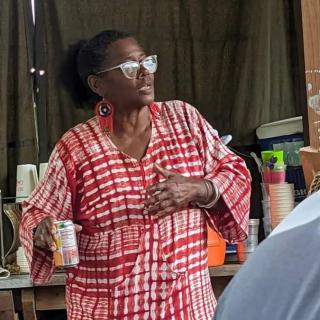Advertisement
Ohio’s jobs “Driver” is getting pretty hot in the Democratic debate as of late, and will likely flare up the Republican stage before Cleveland. I’m following it closely, how can I help it? I can’t go more than two songs on Pandora or watch Prime Time without hearing, in surround sound, the virtues of Fracking.
A few years ago I became a volunteer researcher for the Columbus talk radio show, All Sides with Ann Fisher. Linda, the producer, was a former improv student of mine. I had taught and performed improv and legit theatre for over 20 years, and at 52, I was ready for change, something to sink my teeth into - that would help the world.
At All SidesI researched authors of fiction, non-fiction, history, local celebrities, artists, politicians, ornithologists, etc. And the day Linda gave me the assignment to research fracking, my world changed. And I haven’t looked back.
Fracking, or high volume hydraulic fracturing, is a process the oil & gas industry uses to extract natural gas and oil from shale deposits deep in the ground. Shale drillers look for the hottest (most radioactive) spot in the shale - that’s where they find the best return. Then they dig vertically, from 1-2 miles deep, until they nearly reach the shale, then the drill bit makes a curve horizontally to drill, often times more than a mile, through the shale deposit (the dirt, rocks and sludge that comes out from the bore hole are called drill cuttings or tailings). Then they put down well casings of steel and cement through the bore hole, they perforate the casings with explosives, and force, at extreme high pressure, millions of gallons of water laced with chemicals and silica sand.
This fractures the shale, the sand props open the fractures, and the natural gas and/or oil is released. 60-80% of this Flowback water remains in the earth, where it can seep, leak and migrate into surrounding rock, dirt, and water aquifers. The remainder 20-40% of the Flowback water and Produced water (water already in the earth, full of minerals, dissolved hydrocarbons and often high levels of radionuclides) comes back up, and must be disposed of, because it is now toxic and radioactive from the process and the radionuclides from the shale itself. 1.
Fracking has been proclaimed, and widely advertised, to be our country and state’s solution for energy independence, job development and economic prosperity. And yet it is extremely polluting, hazardous and unsustainable.
The process uses between 2-10 million gallons of water every time one well is fracked, and each well can be fractured up to ten times. The chemicals in the frack fluid contains known carcinogens, endocrine disruptors, neurotoxins, and radionuclides - directly linked with leukemia, breast and bone cancer. Frack Water Waste, often called “Brine,” “Flowback,” or “Produced Water,” is so toxic, it has to be disposed of in injection wells. Injection wells are often times abandoned vertical oil wells, with compromised integrity, or they can be new high volume/high pressure wells.
In fact, Ohio has a business model of importing frack waste from Pennsylvania and West Virginia, as well as our own Ohio shale operations. Youngstown, OH, has suffered earthquakes from injection wells and drilling operations, and Oklahoma is experiencing earthquakes daily from their Fracking and Frack waste injection wells.
The drill cuttings, especially the horizontal leg portion, can be extremely radioactive. In the 2013 Ohio Budget Bill, lawmakers deregulated Frack Drill Cuttings, so now this potentially radioactive dirt can be dumped into 39 Ohio municipal landfills, where radium 226, and 228 can leach into our water supplies.
In addition, methane, a far more potent greenhouse gas than carbon dioxide, is flared at the well sites, is leaking from pipelines, infrastructure, storage facilities, and now from the land, rivers, wetlands and streams around fracked sites.
Surely our law makers and environmental professionals were working on this. But when I approached the Ohio Environmental Council and asked them to initiate a ban on fracking in Ohio, the attorney told me that the Ohio Department of Natural Resources (ODNR) has complete jurisdiction over the Oil & Gas industry in Ohio. OH HB 278, 2004. There was nothing we could do to stop it, except to work on regulating the industry, or to comment on the administrative rules with the Ohio EPA.
Certainly, our State legislators are working on it! So I created an online petition with moveon.org, collected over 2,000 signatures of Ohio citizens, to ban fracking and injection wells in Ohio, and I committed to hand delivering this petition to every State Representative and Senator, Governor Kasich, and our U.S. Senators Brown and Portman. Well, after repeated attempts to get appointments with the law makers themselves, and taking many meetings with their assistants, I decided to wait for them after committee meetings, Caucus, or General Assembly, and then hand deliver the signed petition and ask them to ban fracking and frack waste injection wells in Ohio. It was not surprising to see them turn in their tracks when they saw me coming and scurry off in the opposite direction. Some were flat out rude. Some thoughtfully took the petition. Not one of them would champion a ban. It was “illegal.”
It was then that I turned to the Community Environmental Legal Defense Fund (celdf.org), a non-profit public interest law firm in Pennsylvania. CELDF kept coming up in conversations as having a process with Teeth, a “Rights” based approach to environmental protection. So I attended the two-day Democracy School they produce to help folks understand why our local efforts to protect our natural resources and communities come up against the legal brick wall, and what we can do to change that.
“We don’t have a fracking problem. We have a democracy problem.” Fracking, GMO’s, excessive Water Withdrawal laws, Factory Farms, even Industrial Wind Turbine Farms are some of the harms Communities are currently facing, and they have No say, No rights to stop them under State and Federal preemption laws. In Ohio today, if your neighbor gets a permit from ODNR to build a frack waste injection well in his back yard, guess what, there is nothing you can do about it, because the permit makes it legal.
The Community Rights movement is helping communities reclaim democracy and protect our inalienable rights for pure water, clean air, safe soil, a sustainable energy future, and local self governance. So rather than permitting and regulating these harms, a community can stop them. They can write, initiate and pass at the ballot, their own Community Bill of Rights to protect people, natural communities, environmental, agricultural, labor and economic sustainability.
Thomas Linzey, Esq., is the Co-founder of the Community Environmental Legal Defense Fund. (celdf.org) His early law practice successfully tried environmental offenders in the legal system. The problem was, whatever legal hole they found, litigated against and won, the offender would fix it, and go on polluting. It wasn’t until a group of Pennsylvania farmers and municipal leaders had had enough.
“By the late 1990’s, fear and anger over sludge application in rural Pennsylvania—fueled by the deaths of an 11-year-old who got sick after riding his dirt bike through a sludge-treated field, and a 17-year-old who fell ill after exposure to sludge at a farm—was running high. Thomas Linzey found himself fielding calls from local officials desperate for ways to battle the "biosolids" applicators, as well as the corporate hog farms whose stench sickened people for miles around. Municipalities had been used to keeping those nuisances at bay with their own waste ordinances; but in 1997, in response to agribusiness lobbying, the state began enforcing a law that invalidated the local rules. Residents packed schools and fire stations to air their grievances. "These are the people with the s**tkickers and the John Deere hats," Linzey says. "These are the people who salt the roads in the wintertime and fix the roads in the summertime. We had rural farmers coming to community meetings with the Declaration of Independence in their back pockets."
To help the townships, Linzey wrote model ordinance after model ordinance. One banned corporations from owning farmland, an idea found on the books in nine states; 12 local governments in Pennsylvania passed it. Another banned companies with previous environmental violations from doing business in a township; 5 municipalities adopted that one. An ordinance requiring companies to do extra testing of sludge for health dangers has passed in more than 70 townships.”
Over 200 communities have adopted a citizen-led Community Bill of Rights, standing for their inalienable rights for pure water, clean air, safe soil, a sustainable energy, labor, agricultural, economic future, and local self-governance.
Most of these Community Bill of Rights have been, or will be fought by the Industry, the Municipality, the State. And with CELDF’s legal assistance, these communities will fight back with counter suits, education, and demonstrations. Like our predecessors faced with injustice, the Abolitionists, Suffragists, Civil Rights Advocates, Community Rights organizers and citizens, are working to amend their City and County Charters, their State Constitutions, and ultimately the Federal Constitution, to establish our inalienable rights, of pure water, clean air, safe soil, a Sustainable energy, agricultural, labor and economic future, and Local Self Governance for all Communities.
In June 2014, the Columbus Community Bill of Rights (CCBOR) campaign started collecting signatures from registered Columbus voters, to put the CCBOR on the Columbus Ballot for the November, 2015 election. Due to mid-campaign City of Columbus Charter Amendment time limit rule changes and resistance towards citizen-led ballot initiatives in Columbus, the campaign fell short of the required number of valid signatures - even though we collected over 13,500 signatures.
On March 15, 2016, we kicked off the second CCBOR campaign, and we are aiming to have it on the ballot by or before November 2017.
Our grassroots organization successfully fought off an Ohio EPA permitted Frack Drill Cutting “processing” business effort along the Alum Creek. When adopted, the Columbus Community Bill of Rights will prohibit all fracking, frack injection wells, solid frack waste (drill cuttings) disposal and processing, pipelines, compressor stations and other shale gas development infrastructure, within the City of Columbus. In June, we will kick off the Franklin County Charter Community Bill of Rights, with these same prohibitions.
Currently, there are four counties and three cities working on adopting a Community Bill of Rights to protect the health and well-being of their people, land, natural communities, and future. No longer relying on elected officials to pass laws that govern us in our democracy, We, the People, have the right to pass laws to protect ourselves.
We are active members of the Ohio Community Rights Network ohcommunityrights.org, and the National Community Rights Network. http://nationalcommunityrightsnetwork.org.
Yes, we have a democracy problem, and Yes, we have a huge fracking/frack waste problem. So I, along with thousands of concerned Ohio citizens, demand an end to this toxic industry, and work to protect our water, air, soil and local self governance. It is our right and duty to protect the environment for future generations.
By the way, when you vote this November for our next president - please do your research regarding fracking, and Community Rights. Bernie Sanders, Dem, and Jill Stein, Green, are the only presidential candidates that stand to ban fracking.
Join us. ColumbusBillofRights.org



